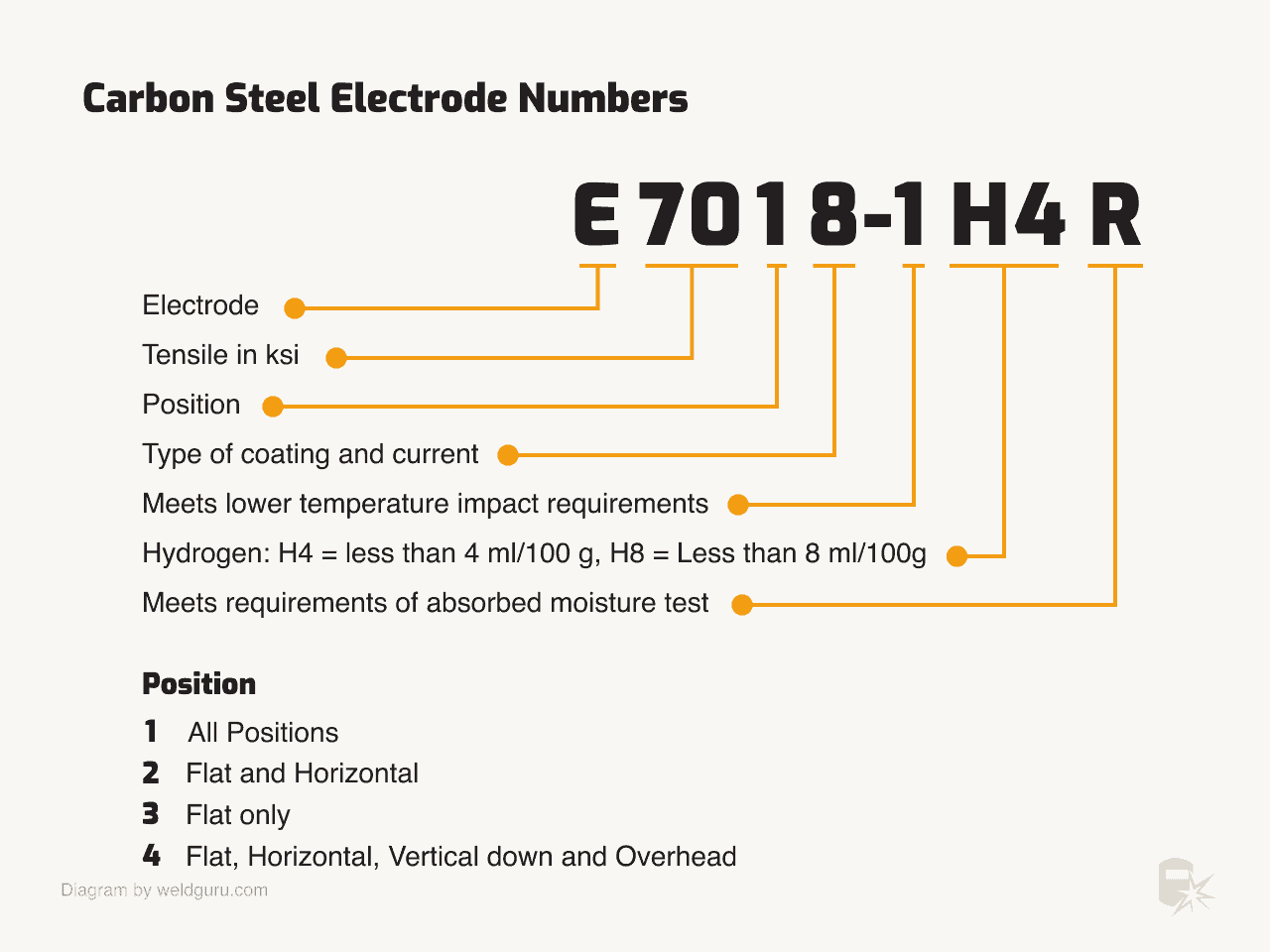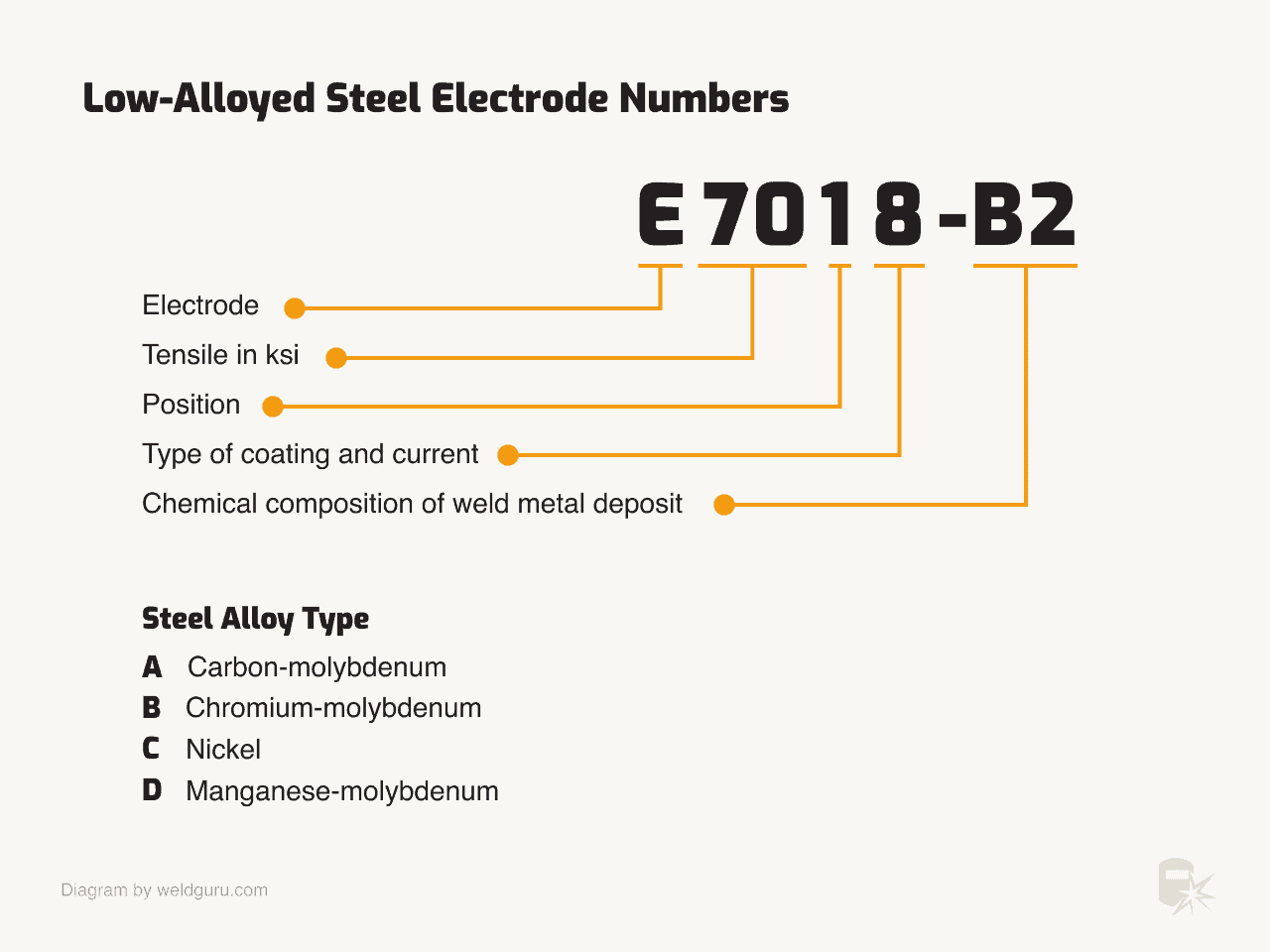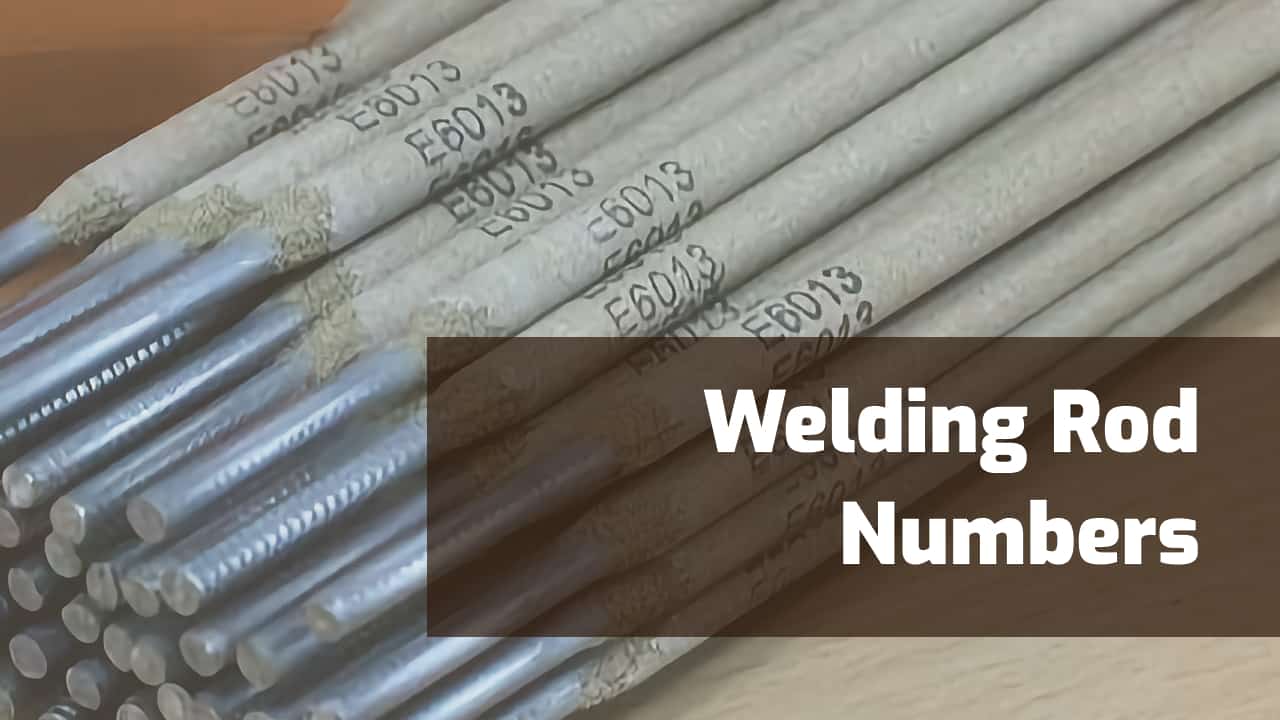There are lots of different welding rod types, each with unique properties. The stamped numbers describe properties like tensile strength, welding position, and flux composition.
They also explain whether power is AC or DC and what polarity you should use.
If you understand these numbers, choosing the right rod for the job is easier.
Breaking Down the Rod Numbers
A standardized system—developed by the American Welding Society (AWS) and industry manufacturers—identifies welding rod properties through four- and five-digit numbers.

© weldguru.com – Image usage rights
Each digit, or pair of digits, has a specific meaning:
- The first two digits indicate tensile strength
- The third digit indicates the welding position
- The fourth digit indicates flux composition
- When there’s a fifth digit, it defines optional designators
Detailed Explanation of Each Digit
To better understand numbers, let’s break them down in depth with examples.
First Two Digits: Tensile Strength
Tensile strength rates the point metal breaks from forces working against when stretched or pulled. It uses pounds per square inch or psi.
You multiply these two digits by 10,000 for the tensile strength rating. The first two digits on a 7018 stick show that a proper weld with this rod has a breaking point of 70,000 psi.
- 60 = 60,000 psi
- 70 = 70,000 psi
- 80 = 80,000 psi
- 90 = 90,000 psi
The Third Digit: Welding Position
The third digit shows welding positions for the rod, meaning whether the joint lays flat and if that rod works best on a horizontal, vertical, overhead, or combination weld.
With a 7018 electrode, we can see it’s useful in any welding position.
But you should only use a 6028 rod on joints that are either flat or horizontal.
- 1 – All positions
- 2 – Flat and horizontal
- 3 – Flat only
- 4 – Flat, horizontal, vertical down, and overhead
Fourth Digit: Flux Composition
The fourth digit describes flux composition. Stick welding uses basic, compound, and rutile fluxes. Basic fluxes provide arcs that are stable, smooth, and quiet.
The arc produced by rutile fluxes creates deeper penetration and higher arc temperatures. Other compounds regulate flow, penetration depth, and rod/flux compatibility with certain metals.
Looking at an E6014 rod using the next table, we see that it works to a 60,000 psi maximum (60), it works in all welding positions (1), and it comes coated in a rutile iron powder flux that works with DC Positive, Negative, and AC (4).
Flux Type Code Table
Below is a table of all the fourth-digit numbers, the flux composition, the penetration, and the current and polarity it can use.
| Rod Code | Flux Type | Penetration Depth | Current, Polarity |
|---|---|---|---|
| 0 | Cellulose, Sodium | Deep | DCEP |
| 1 | Cellulose, Potassium | Deep | DCEP, AC |
| 2 | Rutile, Sodium | Medium | DCEN, AC |
| 3 | Rutile, Potassium | Shallow | DCEP, DCEN, AC |
| 4 | Rutile Iron Powder | Medium | DCEP, DCEN, AC |
| 5 | Basic, Low Hydrogen Sodium | Medium | DCEP |
| 6 | Basic, Low Hydrogen Potassium | Medium | DCEP, AC |
| 7 | Basic, Iron Powder, Iron Oxide | Medium | DCEN, AC |
| 8 | Basic, Low Hydrogen, Iron Powder | Medium | DCEP, AC |
| 9 | Basic, Iron Oxide, Rutile, Potassium (combination) | Medium | DCEN, DCEP, AC |
Related read: What Is Polarity In Welding?
Optional Designators
Sometimes, you’ll find E7XXX electrodes with additional requirements.
You can identify these as “-1,” “H,” “R,” and “M.”
- “-1” – the electrode meets improved toughness and ductility standards for E7018 electrodes and increased ductility in E7024 electrodes.
- “H4” – the electrode meets the standards of diffusible hydrogen testing.
- “R” – the electrode meets the standards of absorbed moisture test / optional supplement for low hydrogen electrodes.
- “M” – the electrode meets most military requirements.
“H” is the most common optional designator and appears as H4, H8, or H16 to indicate the maximum diffusible hydrogen limit of deposited weld metal measured in millimeters per 100 grams (mL/100g). The 4, 8, and 16 indicate what the limit is.
Job requirements dictate which diffusible hydrogen limit level to use.
For example, a job requires an E7018-1 H8 electrode:
- E – Indicates electrode.
- 70 – Indicates tensile strength (70,000 psi or 70 ksi).
- 1 – Indicates it’s an all-position electrode.
- 8 – Indicates a low-hydrogen iron powder covering used with ac or DCEP (reverse polarity).
- -1 – Indicates it has increased toughness (impact strength)
- H4 – Indicates a maximum diffusible hydrogen limit of 4 ml per 100 grams of deposited weld metal
Low Alloy Steel Suffix Codes for Chemical Composition
An electrode number may carry an alphanumeric code following its standard four or five digits, like E7010-A1 or E8016-B2.

© weldguru.com – Image usage rights
This code, often seen with low-alloy steel electrodes, represents the weld metal’s chemical composition.
- “A” represents a carbon-molybdenum steel electrode.
- “B” is for a chromium-molybdenum steel electrode.
- “C” signifies a nickel steel electrode.
- “D” denotes a manganese-molybdenum steel electrode.
The last number in the suffix falls under one of these general chemical categories, providing an idea of its chemical composition.
For example, let’s take the electrode E7018-B2L:
- E—Indicates electrode.
- 70—Indicates tensile strength (70,000 psi or 70 ksi).
- 1—Indicates it’s an all-position electrode.
- 8—Indicates a low-hydrogen iron powder covering used with ac or DCEP (reverse polarity).
- B2L—Indicates that the deposited metal chemical composition is a low-alloy chromium-molybdenum steel with 1.25% chromium and 0.50% molybdenum. It also has a lower carbon content, which reduces cracking in the weld.
You can get the exact chemical composition of these rods from the electrode manufacturer.
Below is a chart of the different suffixes, indicating chemical composition ranges.
| Suffix | Steel Alloy Type | Suffix Number Description |
|---|---|---|
| -A1 | Carbon-Molybdenum | 0.40% – 0.65% Mo |
| -B1 | Chromium-Molybdenum | 0.40% – 0.65% Cr 0.40% – 0.65% Mo |
| -B2 | Chromium-Molybdenum | 1.00% – 1.50% Cr 0.40% – 0.65% Mo |
| -B2L | Chromium-Molybdenum | B2 with lower Carbon |
| -B3 | Chromium-Molybdenum | 2.00% – 2.50% Cr 0.90% – 1.20% Mo |
| -B3L | Chromium-Molybdenum | B3 with lower Carbon |
| -B4L | Chromium-Molybdenum | 1.75% – 2.25% Cr 0.40% – 0.65% Mo |
| -B5 | Chromium-Molybdenum | 0.40% – 0.60 Cr 1.00% – 1.25 Mo |
| -B6 | was E502 | 4.6% – 6.0 Cr 0.45% – 0.65 Mo |
| -B8 | was E505 | 8.0% – 10.5% Cr 0.8% – 1.2% Mo |
| -C1 | Nickel Steel | 2.00% – 2.75% Ni |
| -C1L | Nickel Steel | C1 with lower Carbon |
| -C2 | Nickel Steel | 3.00% – 3.75% Ni |
| -C2L | Nickel Steel | C2 with lower Carbon |
| -C3 | Nickel Steel | 0.80% – 1.10% Ni |
| -NM | Nickel-Molybdenum | 0.80% – 1.10% Ni 0.40% – 0.65% Mo |
| -D1 | Manganese-Molybdenum | 1.00% – 1.75% Mn 0.25% – 0.45% Mo |
| -D2 | Manganese-Molybdenum | 1.65% – 2.00% Mn 0.25% – 0.45% Mo |
| -D3 | Manganese-Molybdenum | 1.00% – 1.80% Mn 0.40% – 0.65% Mo |
| -W | Weathering Steel | Ni, Cr, Mo, Cu |
| -G | No required chemistry | |
| -M | Military grade | May have more requirements |
Remember that many rods come in batches, and you can’t buy them on Amazon.
Most home welders and production line welders will never need these codes.
Rod Numbers For Stainless Steel
The welding rod electrode identification system for SMAW stainless steel is slightly different.
Instead of the tensile strength shown, it uses the American Iron and Steel type of stainless steel.
- E – Indicates electrode for arc welding.
- First three digits – indicates the American Iron and Steel type of stainless steel.
- Last two digits – indicates the position and current used. This is the same coding system as above.
Using E308-16 (sometimes shown as 308L) as an example:
- E – Indicates electrode
- 308 – This is the type of stainless steel
- 1 – Is all positions
- 6 – Is the current AC & DCEP
Wrapping It Up
These codes are essential to welding quality. For most casual welders, you’ll only need to know the first four digits.
Learn them, know them, and you’ll know exactly what one to use for your project if you’re ever in doubt.
